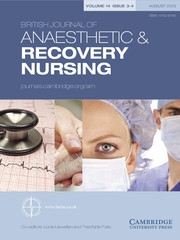Article contents
Laryngospasm
Published online by Cambridge University Press: 25 February 2009
Extract
Laryngospam is a relatively common airway emergency. Mevorach [1996] cites Olsson and Hallen [1984] who found a mean incidence of 8.6/1000 in adults and 27.6/ 1000 in children. From these figures it can be assumed that most post anaesthetic care nurses at some time in their career will encounter it. Prompt action is required, and knowledge of the physiological processes involved along with an appreciation of the treatment options available. This article will aim to discuss laryngospasm and will examine briefly the phenomenon of post laryngospasm induced pulmonary oedema.
- Type
- Research Article
- Information
- British Journal of Anaesthetic & Recovery Nursing , Volume 2 , Issue 3-4 , August 2001 , pp. 23 - 25
- Copyright
- Copyright © British Association of Anaesthetic and Recovery Nursing 2001
References
references
- 2
- Cited by


